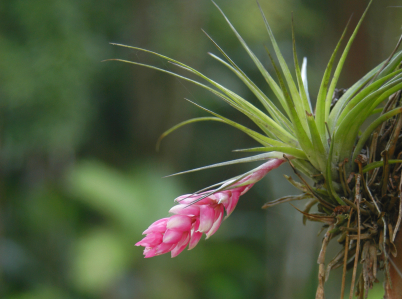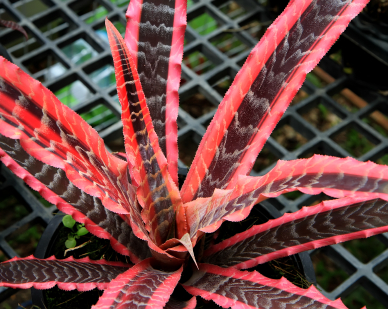Growing Bromeliads Together
Author: Celeste BoothNo Comments
Care and Culture, Growing Indoors
There is no better way to learn than through experience so we want to connect our readers someone who is experiencing growing bromeliads for the first time. We would like to introduce a guest blogger to our site. Sarah is a beginner bromeliad grower and will walk through her first bromeliad growing experiences with us. From the beginning stages of choosing a bromeliad to the end result of dividing and repotting pups, once a month Sarah will share her bromeliad knowledge with us, learning as she goes.
CLEANING THE AIR

Bromeliads are wonderful for the environment.
I wanted to start growing a few indoor houseplants because I have read they are good for cleaning the air in your home. There is a NASA study out there that a lot of indoor plant enthusiasts reference. They discovered that indoor plants are good at removing Volatile Organic Chemicals or VOCs from the air. These are the indoor pollutants that have potential to make you feel gross. They can cause headaches, soar throats, coughs, and just general not feeling well. Bromeliads are noted for being good at removing formaldehyde and xylene from the air.
I want my family to feel well, have a lot of energy and have more exposure to green and living things. It makes sense to me to bring plants indoors. I think we will all benefit.
I have only ever had two indoor plants. The first one died almost immediately. The second one I’ve had for about six months and it seems to be doing ok even though its takes some abuse. It rarely requires water and doesn’t seem to mind being far away from a window. Both plants were from the garden department in big box stores.
ADDING BROMELIADS
I decided to add some bromeliads to expand my humble indoor plant collection because they exude tropical energy and are supposed to be easy to take care of. Our family could use a little tropical this time of year. I like the easy to care for part because I have an infant and a toddler that keep me very busy and very distracted. Taking care of kids can make it tough to remember to take care of houseplants. If I am able to develop some discipline and do well with these bromeliads, maybe I can delve into something a bit more complicated.
ORDERING
After reading the Essential Bromeliad Buyer’s Guide I decided to order my bromeliads from Tropiflora. Their site is easy to use and I was able to search by bromeliads that are ideal for beginners. When I started an account they gave me a five dollar credit! I will wait until after the holidays to place my order because we are traveling and I would hate for the bromeliads to arrive and have no one to look after them. I want to order the plants instead of getting them from a big box store this time because I am hoping that starting with quality plants which I know are good for beginners will give me a head start in growing long lasting, healthy bromeliads.
If you don’t have access to a specialty store, don’t let that hold you back. Most large chain stores with a garden or plant department will carry bromeliads.
FOR MY KITCHEN TABLE

Vibrant bromeliads add color and life to any home.
I chose a Guzmania lingulata ‘Teresa’ and a Tillandsia ionatha ‘Fuego.’
I picked the Guzmania because it is small, but densely leaved with a colorful flower. I want a small tabletop plant to start. When the kids are older maybe I can think about a larger bromeliad to put on the floor.
I plan to put the Guzmania on my kitchen table. The Tropiflora description says the plant can handle partial sun to full shade. We have a large west facing window in our kitchen nook. It gets a good amount of daylight, but our table is not directly under the window. I also forget to open the blinds most mornings. Hopefully this plant can survive with the amount of light available there.
AIR PLANTS
The Tillandsia ionatha ‘Fuego’ caught my eye because I love the bright color of the leaves and I am fascinated by the idea of air plants. Supposedly these plants can be attached to almost anything. They can even grow on nothing but a string dangling in the air. I’m excited to see if that is true. In their natural environment air plants grow attached to trees and shrubs and reproduce incredibly fast. Also, this species is relatively common so I’m hoping that means it is easy to grow.
I will hang the Tillandsia in the window over my kitchen sink. It faces the same direction as the window in our kitchen nook, but it does not have any blinds or window covering. In the summer there is a very large tree that shades the house for most of the day. Hopefully it will provide enough light for the Tillandsia to grow, but not so much that it will burn.
Tillandsias also need high humidity, so I am hoping the air will be a little more moist around the kitchen sink.
POTENTIAL TROUBLE SPOTS
My family lives in Southeast Arkansas where the weather is extremely hot in the summer and still gets pretty cold in the winter. We spend a lot of time indoors due to the temperatures and the mosquitoes, so I am excited to have some bright and cheery plants inside. Because we run either heat or air conditioning continually all year, I know we will have to watch our humidity levels and not let these plants get too dried out. Our windows are very drafty so I will also have to be careful about big temperature swings.
MY GOALS
My ultimate goal is to keep these plants alive long enough to see them bloom and produce offsets. Eventually I want to separate the pups to give them to my friends and neighbors. It would also be fun to try some crafting with the Tillandsia. Maybe I can come up with some creative mounts.
WORKING TOGETHER
We can work on this growing project together. I will share what I learn as I go and hopefully we will all become expert bromeliad growers. Do you have a green thumb when it comes to houseplants? What bromeliads do you want start with?
MY THREE PIECES OF ADVICE
My three pieces of advice that I will leave you with this month are:
- Choose the spot you want to use to display your plant first and then choose your plant. You can find a plant whose light needs fit in with your location. It is easier to avoid disappointment this way.
- If you can, buy or order a plant from a specialty retailer. You will know exactly what kind of plant you are getting and what its needs are.
- Do your research. What kind of care will your plant need? If you want to be successful find a plant that fits into your lifestyle. I chose two plants that won’t need too much direct attention.
Have fun getting started!
Sources
“Clean Air Plants and Sick Building Syndrome.” Plant Lady
“Frequently Asked Questions.” Bromeliad Society International.
Tropiflora.

Resource Download
Hechtia Care Cheat Sheet
Learn how to care for your Hechtia bromeliad with this quick and easy informational guide.
Learn More
Ask an Expert
Questions about bromeliads?
Our experts love a challenge!
Photo of the Week
Submit your photo to be featured on the blog!
More Photo of the Week Winners
Submit Photo







